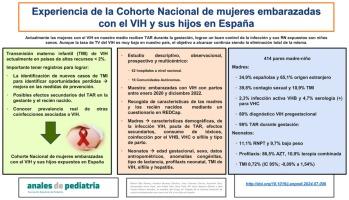西班牙全国感染艾滋病毒孕妇及其婴儿队列的经验:艾滋病毒母婴传播及相关感染的演变情况
IF 1.5
4区 医学
Q2 PEDIATRICS
引用次数: 0
摘要
导言:在高收入国家,艾滋病垂直传播率(VTR)已下降到不足 2%,尽管如此,围产期感染仍在继续发生。我们提供了西班牙感染艾滋病毒的孕妇及其子女的全国队列数据。我们的目标是描述这一人群的特征,评估 HIV VTR、抗逆转录病毒疗法(ART)的安全性以及合并感染的发生率。患者和方法62 家医院参与的多中心前瞻性、观察性和描述性研究。研究样本包括在 2020 年 1 月至 2022 年 12 月间出生婴儿的女性艾滋病病毒感染者。我们使用在线问卷(REDCap 网络应用程序)收集了有关母亲和孩子特征的前瞻性数据。大多数母亲是移民(227/349;65.1%)。艾滋病毒感染的主要途径是异性传播(160/402;39.8%),其次是垂直传播(44/402;10.9%)。313/389名妇女(80.4%)在受孕前被确诊,394/402名妇女(98%)在怀孕期间接受了抗逆转录病毒疗法,356/402名妇女(89.3%)在分娩时检测不到病毒载量。230/388(59.3%)名婴儿经阴道分娩。早产比例为 11.1%。最常见的新生儿预防方法是齐多夫定单药治疗(358/414;86.5%)。有 3 例艾滋病毒垂直传播(95% CI,0%-1.54%)。结论目前,西班牙大多数感染艾滋病毒的妇女在受孕前就得到了诊断,她们都是外籍人士,感染得到了很好的控制。虽然西班牙的 VTR 很低,但仍有一些感染是可以通过早期诊断和治疗来预防的。本文章由计算机程序翻译,如有差异,请以英文原文为准。

Experiencia de la cohorte nacional de mujeres embarazadas que viven con VIH y sus hijos en España: evolución de la transmisión materno-infantil de VIH e infecciones asociadas
Introduction
The vertical transmission rate (VTR) of HIV has decreased to less than 2% in high-income countries., in spite of which perinatal infections continue to occur. We present data from the national cohort of pregnant women living with HIV and their children in Spain. The objectives were to describe the characteristics of this population, evaluate the VTR of HIV, the safety of antiretroviral therapy (ART) and the prevalence of coinfection.
Patients and methods
Multicentre prospective, observational and descriptive study with participation of 62 hospitals. The sample included pegnant women living with HIV whose children were born between January 2020 and December 2022. We collected prospective data on the characteristics of mothers and children using an online questionnaire (REDCap web application).
Results
The study included 414 mother-child dyads. Most mothers were immigrants (227/349; 65.1%). The main route of HIV infection was heterosexual transmission (160/402; 39.8%), followed by vertical transmission (44/402; 10.9%). The diagnosis was made before conception in313/389 women (80.4%), 394/402 (98%) received ART during pregnancy and 356/402 (89.3%) had an undetectable viral load at the time of delivery. The delivery was vaginal in 230/388 children (59.3%). The proportion of preterm birth was 11.1%. The most frequent neonatal prophylaxis approach was monotherapy with zidovudine (358/414; 86.5%). There were 3 cases of vertical transmission of HIV (95% CI, 0%-1.54%). Only one newborn was breastfed.
Conclusions
At present, most women living with HIV in Spain receive the diagnosis before conception, are of foreign ancestry and achieve good control of the infection. Although the VTR is very low in Spain, there are still infections that could be prevented with early diagnosis and treatment.
求助全文
通过发布文献求助,成功后即可免费获取论文全文。
去求助
来源期刊

Anales de pediatria
医学-小儿科
CiteScore
2.10
自引率
4.80%
发文量
155
审稿时长
44 days
期刊介绍:
La Asociación Española de Pediatría tiene como uno de sus objetivos principales la difusión de información científica rigurosa y actualizada sobre las distintas áreas de la pediatría. Anales de Pediatría es el Órgano de Expresión Científica de la Asociación y constituye el vehículo a través del cual se comunican los asociados. Publica trabajos originales sobre investigación clínica en pediatría procedentes de España y países latinoamericanos, así como artículos de revisión elaborados por los mejores profesionales de cada especialidad, las comunicaciones del congreso anual y los libros de actas de la Asociación, y guías de actuación elaboradas por las diferentes Sociedades/Secciones Especializadas integradas en la Asociación Española de Pediatría.
 求助内容:
求助内容: 应助结果提醒方式:
应助结果提醒方式:


